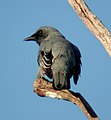Sahul cicadabird
| Sahul cicadabird | |
|---|---|

| |
| Scientific classification | |
| Domain: | Eukaryota |
| Kingdom: | Animalia |
| Phylum: | Chordata |
| Class: | Aves |
| Order: | Passeriformes |
| Family: | Campephagidae |
| Genus: | Edolisoma |
| Species: | E. tenuirostre
|
| Binomial name | |
| Edolisoma tenuirostre (Jardine, 1831)
| |
| Synonyms | |
|
Coracina tenuirostris | |
The Sahul cicadabird (Edolisoma tenuirostre), previously known as the common cicadabird or slender-billed cicadabird, is a species of passerine bird in the family Campephagidae. It is found in Australia, New Guinea and the Bismarck Archipelago. Its natural habitats are temperate forest and subtropical or tropical moist lowland forest.[2] The species is placed in the reinstated genus Edolisoma by most authors.[3] The common cicadabird was described as a "great speciator" by Mayr & Diamond (2001);[4] and Pedersen et al. (2018)[3] described how this species rapidly colonized and diversified across the Indo-Pacific island region and Australia in the Pleistocene.
Subspecies
[edit]Six subspecies are recognised:[5]
- E. t. nehrkorni Salvadori, 1890 – Waigeo (Raja Ampat Islands, northwest of New Guinea; known from one specimen)
- E. t. aruense Sharpe, 1878 – Aru Islands (southwest of New Guinea) and southwest, central south New Guinea
- E. t. muellerii Salvadori, 1876 – Kofiau and Misool (Raja Ampat Islands, northwest of New Guinea), New Guinea (except south), D'Entrecasteaux Archipelago (east of southeast New Guinea), Long (west of New Britain) and Sakar (north of Umboi Island, west of New Britain; southwest Bismarck Archipelago)
- E. t. tagulanum Hartert, EJO, 1898 – Misima and Tagula Island (west, central Louisiade Archipelago, east of southeast New Guinea)
- E. t. melvillense (Mathews, 1912) – northeast Western Australia to Cape York Peninsula, northeast Queensland (north Australia)
- E. t. tenuirostre (Jardine, 1831) – central east Queensland to southeast Victoria (east Australia)
Under the name "common cicadabird" this species formerly included 21 subspecies. Based mainly on a molecular phylogenetic study published in 2018,[3] the species was split and seven new species were recognised. The new species are: the Rossel cicadabird, Geelvink cicadabird, Banggai cicadabird, Obi cicadabird, North Moluccan cicadabird, South Moluccan cicadabird and the Timor cicadabird.
Gallery
[edit]-
Kobble Creek, southeast Queensland
-
Adult male and juvenile, Rush Creek, southeast Queensland
-
Crossroads Reserve, New South Wales
References
[edit]- ^ BirdLife International (2017). "Edolisoma tenuirostre". IUCN Red List of Threatened Species. 2017: e.T103702470A118729711. doi:10.2305/IUCN.UK.2017-3.RLTS.T103702470A118729711.en. Retrieved 17 November 2021.
- ^ BirdLife International.
- ^ a b c Pedersen, M.P.; Irestedt, M.; Joseph, L.; Rahbek, C.; Jønsson, K.A. (2018). "Phylogeography of a 'great speciator' (Aves: Edolisoma tenuirostre) reveals complex dispersal and diversification dynamics across the Indo-Pacific". Journal of Biogeography. 45 (4): 826–837. doi:10.1111/jbi.13182. hdl:11250/2593769. S2CID 46029743.
- ^ Mayr, E.; Diamond, J.M. (2001). The Birds of Northern Melanesia: Speciation, Ecology and Biogeography. New York: Oxford University Press. ISBN 978-0-19-534966-5.
- ^ Gill, Frank; Donsker, David; Rasmussen, Pamela, eds. (August 2024). "Bristlehead, butcherbirds, woodswallows, Mottled Berryhunter, ioras, cuckooshrikes". IOC World Bird List Version 14.2. International Ornithologists' Union. Retrieved 23 September 2024.
External links
[edit]- ABID Images
- On the HBW Internet Bird Collection
- Species factsheet Archived 2015-09-24 at the Wayback Machine - BirdLife International



